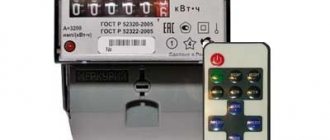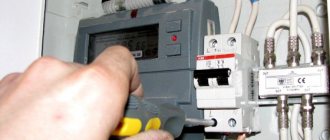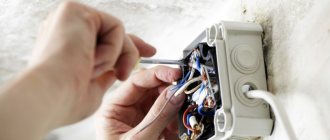Nowadays we cannot live without electricity – it has become an integral part of our everyday life. But it is given to us for a reason – we have to pay for it. To ensure that costs are adequate to the amount of energy consumed, special consumption metering devices are used. In common parlance, we are accustomed to calling them electric meters or electricity meters.
What to do if the electricity meter is broken?
We have known this device since childhood. But until you become the owner or renter of a home, you don’t really think about where the meter comes from, who it belongs to, and what regular activities it requires. Or, for example, what to do if the electricity meter breaks down - who to contact, how long to wait for the issue to be resolved, how to pay during the period until the problems are fixed, how much money to prepare for a new meter - etc. And you need to know this!
Therefore, we will try to at least to some extent fill this “blank spot” with useful information.
Types of electricity meters and their problems
All electricity metering devices in our houses and apartments today can be divided into two main types:
- Induction devices. In this case, there is a metal disk on the meter display that begins to rotate when an electric current (electromagnetic induction) occurs. This disk is connected to gears that transmit rotation to wheels with numbers (counter readings).
- Electronic devices. Here, the analog signals received by the sensor are converted into a digital code, which is displayed on the device display. You do not need to look at the rotation of the disk, since it is not here - the normal functioning of the counter is indicated by a red diode light on the display.
Who has the right to repair or change electricity meters?
Everything is quite simple, but it must be done quickly. If there is light in the house, but the meter does not record electricity consumption, there is a temptation to take advantage of free electricity. Do not do that! You can run into a large fine for theft of electrical energy.
- The arriving specialist inspects the metering device, determines the malfunction and, if possible, eliminates it on site or installs a new device. In municipal housing, the meter is installed free of charge. Otherwise, you purchase an electricity meter at your own expense. If the electric meter is subject to repair, but it is impossible to carry it out on site, it is removed and transferred to an energy sales laboratory or another company that has the right to carry out such work. After the repair work is completed, the meter is installed in its original place.
- After performing all of the above manipulations, the electrician is required to draw up a report describing the nature of the breakdown and the appearance of the meter. Please read this document carefully. You never know what will be written there, you will have to pay for everything! Especially pay attention to the fact that the drawn up report clearly states that the seals are not damaged and there are no signs of the device being tampered with. This will save you from being charged with electricity theft. The drawn up report is submitted to the energy supply and management companies to properly record the results of repairs or replacement of the electricity meter.
- If the electric meter is replaced with a new device, it must be sealed. This operation is performed by an authorized employee of the management company or electricity supplier. Until the seals are installed, the electricity meter is considered not to be put into operation and payment for consumed electricity is carried out according to the standards approved by the Government of the Russian Federation. The act of installing seals on the electric meter indicates the date of the work, based on which the next deadline for state verification of the electricity meter is determined according to the established regulations.
We examined in detail the question of what to do if the electricity meter burns out. We only have to consider one nuance, namely: how to pay for electricity during the period of repair or replacement of the electric meter? Everything is simple here! During the first three months, payment is made based on average monthly electricity consumption for the last year.
Turning the situation to your advantage is a logical and understandable desire. Therefore, many, faced with the fact that a broken meter has started counting in their favor or has stopped completely, decide to leave it faulty. Even if we reject morality and the idea that everything will be rewarded, then such behavior is illegal.
What awaits the unlucky freebie lover? Variants are possible. Any meter undergoes verification every few years, and its readings can be checked by a representative of the resource supply organization at any time. In both cases the fault can be noticed.
And then the subscriber may be ordered to pay for the services consumed not according to the readings of the meter from the moment when it was last in working order. An additional fine may be imposed. Naturally, the owner of the home where this meter is installed will also be required to fix the problem.
Video description
Replacement information if the counter does not work.
But imagine that you take monthly readings from the device and see that they are almost twice as high as the consumption that was last month. This is certainly a red flag, but before contacting your electricity supplier about this, you should consider the following factors:
- The day began to wane, and it began to get dark much earlier. When daylight hours decrease, this does not mean that people start turning on the lights in all rooms, wasting electricity, no, they watch TV and turn on the computer more often.
- It's also getting cooler, so many people turn on the electric kettle to make themselves a hot drink. Coffee machines and coolers can also be connected to the network, although this applies more to offices. People are starting to use hot water more often, therefore, the electric boiler consumes more energy.
- Even at home, not to mention offices, in the autumn cold, when centralized heating has not yet been connected, they use various electric heaters such as a blower, a fireplace, or a heater.
Note: In summer, electricity consumption may increase significantly due to the air conditioner being constantly on.
What should a subscriber do if he notices a malfunction?
So what to do if the electric meter breaks down? The subscriber’s very first step should be to contact the electricity supplier orally or even in writing - the address and contact numbers must be indicated on payment receipts. Explain the situation as you see and understand it - do not try to do it at the level of a power engineer with a higher education. In any case, a company representative will explain what your next steps should be - most likely, you will be asked to remain at home for a visit from their representative. But the rules in different localities may differ, so the procedure may be slightly different.
An approximate troubleshooting algorithm looks like this:
- You pay for the call and work of the electrician at the bank specified by the company (usually within 650-750 rubles). After providing a receipt for payment by the subscriber, the replacement request is recorded by the operator.
- You are assigned a day on which someone must be at home to allow the inspector to see the electrical appliance - he will record the readings and draw up a report on the need to install a new appliance. You don’t have to be at home - you can ask one of your relatives, friends or neighbors. Most often the time is specified (before or after lunch).
- On your part, if the electricity meter breaks down, you will have to pay for a new device. Its cost will be from 620 rubles or more - it all depends on the model of the device and the type of metering. After this, an electrician will come and carry out the replacement, but the dispatcher will again agree with you on the time of his visit.
And here is another option for the subscriber - you can directly contact the management company (the phone number is easy to find on the Internet). But this is the most extreme case, since any supplier, having learned that his subscriber’s electricity meter has broken down, is simply interested in replacing it, since this is their income, which they are unlikely to give up voluntarily. In addition, appealing to higher authorities is always red tape and you will have to wait much longer, although in the end a representative of your supplier will still come to you.
Which organizations to contact
If your meter fails, immediately call your home's energy supply company and notify them of the situation. Assess the possible danger posed by a faulty measuring device; it may buzz, smell like burning, or smoke.
In this case, you should immediately turn off the voltage supply to the input. Next, you will need to come to the energy supply organization and write a statement that will oblige its employees to come to the site to carry out repairs. Immediately check the date and time of the specialists’ visit.
Under no circumstances should you attempt to repair the electricity meter yourself. Even if you just need to “correct” the contact, you will have to open the seal, which is prohibited by law and subject to a serious fine.
Having arrived at the site, the inspector will prepare and write a report that will testify to the malfunction of the device measuring electricity consumption. Before this, he will check whether there has been any interference with the operation of the meter and write off its last readings. Don’t forget to ask the inspector about the cause of the breakdown and make sure that he writes it down in the report. This will help avoid further problems when determining who is responsible for the breakdown.
What not to do
Let's start with the fact that you shouldn't go where you shouldn't - everyone knows about this, but not everyone adheres to such a wise and simple rule. So, if your electricity meter is broken, do not try to fix the problem yourself, and there are several reasons for this.
Do not try to fix the problem yourself if the electric meter is broken Source bezriskoff.ru
Do not try to fix the problem yourself
Why you shouldn't do things yourself:
- First of all, such actions are dangerous to human health and even life. The danger is electric shock. The risk increases significantly when the meter is located in the entrance on a common control panel. The meters are hung there quite tightly and at the same time the zero buses are open - for someone who does not understand the structure of such equipment, this can end disastrously.
- You may accidentally damage one of the seals installed on the device. Then you are unlikely to be able to convince company representatives that it was an accident and as a result you will have to pay a considerable fine (they are also interested in this).
- If the electric meter breaks down and you try to remove it yourself, you may touch the neighbors’ connection terminals and they will be left without light. This will result in an additional call for an electrician, for which you need to pay, and, at a minimum, damaged relationships with residents who are left without electricity.
Global changes in the energy consumption metering system
First of all, we remove the “confusion” in the interpretations
Yes, you'll have to start with this! When preparing to work on this publication, while reading articles on the topic of electricity meters, the author encountered extremely contradictory information. Moreover, the disagreements were not about trifles or minor nuances, but about fundamental issues. I had to search for the truth, immersing myself in legislative documents that were quite difficult for normal reading.
And of course, there is no “confusion”. It’s just that some confusion regarding the interpretation of the rights and obligations of citizens and organizations involved in organizing electricity consumption accounting is, alas, caused by quite a few unscrupulous authors of articles published on the Internet on this topic.
Expert opinion: Afanasyev E.V.
Chief editor of the Stroyday.ru project. Engineer.
There are no special complaints about those copywriters whose publications were written before 2022. Some have presented the question more talentedly, some have more tongue-tied explanations, others simply “torn” the text almost to the level of plagiarism. But the information, in principle, was appropriately relevant. But those who continued and continue to this day “with a blue eye” to rewrite the same “postulates” after changes in legislation, without bothering to clarify: were there any changes?, and without finding the time to simply raise the original sources - these would-be authors are guilty of complete misinformation of readers and discrediting their Internet sites.
Now let's explain everything.
The main law regulating all legal relations in the field of electricity consumption, accounting and payment for this consumption, delimitation of duties and areas of responsibility and other important issues is the federal law “On Electric Power Industry”.
The main legislative act in the field of electricity consumption is the Federal Law “On Electric Power Industry”.
This act was adopted quite distantly in 2003, received registration number N 35-ФЗ dated March 26, 2003. Over the past almost two decades, various amendments, changes and additions have been repeatedly made to it. This is not surprising - we all witnessed the rapid development of technology at the start of this century. And what seemed relevant and even innovative turned out to be “yesterday” after a couple of years. This especially affected communication systems, transmission and processing of information.
Numerous amendments did not directly seriously affect end consumers, which is why they stopped paying attention to them at the grassroots level. But everything changed seriously with the adoption of Federal Law No. 522-FZ of December 27, 2022, literally called “On amendments to certain legislative acts of the Russian Federation in connection with the development of electrical energy (power) metering systems in the Russian Federation.”
A law that has changed a lot in the relationship between suppliers and final household consumers of electrical energy.
This one act amended four legislative documents:
- In the already mentioned Federal Law of March 26, 2003 N 35-FZ “On Electric Power Industry”.
- In the Housing Code of the Russian Federation.
- In the Town Planning Code of the Russian Federation.
- In the Federal Law of November 23, 2009 N 261-FZ “On energy saving and increasing energy efficiency and on introducing amendments to certain legislative acts of the Russian Federation.”
As is usually practiced, after a certain time, the Decree of the Government of the Russian Federation of June 29, 2020 N 950 “On introducing amendments to certain acts of the Government of the Russian Federation on improving the organization of electricity metering” followed, which already outlined specific practical steps for the implementation of previously introduced amendments to the Law.
The Government, by its Resolution, explains in more detail the mechanism for implementing the requirements of the Federal Law.
The main idea that runs like a “red thread” through these documents is that from July 1, 2022, the widespread transition to intelligent metering systems for electricity consumption will begin, and from 2022 it will reach the calculated mass level.
What kind of “beast” is this, an intelligent electrical energy metering system? We quote the law:
This is “...a set of functionally integrated components and devices intended for remote collection, processing, transmission of readings from electrical energy metering devices, providing information exchange, storage of readings from electrical energy metering devices, remote control of its components, devices and electrical energy metering devices, without affecting the results of measurements performed by electrical energy metering devices, as well as the provision of information on measurement results, data on the quantity and other parameters of electrical energy in accordance with the rules for providing access to the minimum set of functions of intelligent electrical energy (power) metering systems, approved by the Government of the Russian Federation.”
Now that the fundamental difference has become clear, let’s figure out how this will affect us, that is, energy consumers at the household level.
What is changing for citizens - energy consumers
All meters will be “smart”!
Smart meters are nothing new. They had already appeared in small series a dozen years ago, and were even actively used in certain sections of the urban power grids of some Russian megacities - in all likelihood, test tests were carried out in this way. The accumulated experience has made it possible to make plans for a universal transition to such energy consumption metering devices.
Expert opinion: Afanasyev E.V.
Chief editor of the Stroyday.ru project. Engineer.
To tell the truth, such a transition suggests itself - today the “army” of old electric meters looks too varied. From enduring electromechanical devices with a rotating disk to modern ones with liquid crystal displays. Moreover, all this still needs to be multiplied by the huge variety of models. It is no wonder that maintaining order in such an accounting system is very difficult. Perhaps this is why Russia, unfortunately, is among the leaders in electricity losses.
Nonsense - a shield in the entrance on the landing. Four apartments - and four different models of electricity consumption meters!
It was decided to put an end to such “Babylonian pandemonium” once and for all. In accordance with the updated requirements of the Law, starting from July 1, 2022, utility workers are recommended to switch to installing “smart” meters that can work with a smart metering system for energy consumption. This is the first, preparatory stage of the overall reform.
But from January 1, 2022 (very soon!) such an installation will become mandatory.
And then there’s a very important innovation. Previously, purchasing a meter was the responsibility of citizens – energy consumers. Now this is the exclusive prerogative of the organization involved in energy supply.
What is a “smart” meter?
One of the modern models that fits the definition of “smart meter”
This is a metering device, which, according to the plan, should save the user from many intermediate operations of reading and transmitting information to the energy supply company. The device takes care of all the calculations, taking into account possible benefits for the consumer and multiple tariffs, informs the user of the amount to be paid, and informs the supplying organization of the exact amount of energy consumed. Moreover, this data can be detailed by time, by the quality of the supplied energy (strong drops or, conversely, power surges), which, according to the plan, should make it easier to resolve disagreements when they arise.
Diagram of the relationship between a smart meter and the energy supplier company and the consumer.
It is planned to actively use Internet protocols to transfer information, especially in terms of wireless communication (Wi-Fi) from the meter to the router, and then to the general network. Duplication of channels via GSM or innovative LPWAN systems is possible. The user must gain access to detailed information (in addition to visually directly on the meter) through a mobile application. It is expected that this application will be able to analyze consumption, compare it with previous periods, present information in an easily digestible graphical form, which will help streamline energy costs and provide tangible savings.
What else should such a “smart” meter be able to do?
- Such a device is capable of conducting diagnostics of the network it serves and self-diagnosis, and reporting to the “center” and its consumer about identified problems.
- Independently switch to the currently valid temporary electricity payment tariffs.
- Immediately report to the control room about an accident, an attempt at unauthorized opening, illegal connections and other similar information.
- Notify users about accumulated debts for payment of consumed energy.
- Store accumulated information in built-in non-volatile memory.
It must be said that the experience of using such smart meters shows that they fit perfectly into the concept of a “smart home”, and are indeed capable of achieving considerable cost savings, stimulating careful use of energy.
Who will install such meters and when? At whose expense?
Let us immediately reassure readers - you should not expect any kind of emergency. Judging by the changes made to the laws, the replacement of old electricity consumption meters with new ones will be carried out gradually.
Namely, from January 1, 2022, they will, at least initially, be installed only to replace old ones that have failed, have reached their service life limits or the current calibration interval. In the latter case, the metering device will no longer be sent for the next verification, but will simply be taken out of service.
Of course, the replacement will be accompanied by some kind of well-established procedure for putting the new system into operation with user instructions and testing of communication channels.
It is clear that in new buildings new “smart” meters will be installed immediately by default. At the same time, no distinction is made whether these are multi-apartment houses, mass urban development, or suburban, private ones, in cities, towns, or villages. Only the company responsible for the installation changes.
Thus, the entire installation of meters for smart metering systems for electricity consumption in urban multi-storey buildings is entrusted to the guaranteeing supplier. In the private sector, the local electricity network (grid company) will be responsible for this.
Now let’s ask ourselves the question: “at whose expense is the banquet?” Alas, there is nothing particularly to be happy about.
Yes, the amendments say that the responsibilities for purchasing and installing equipment are assigned to the energy supply organizations mentioned in the previous paragraph. That is, the consumer will not need to search, select and purchase a metering device for his own money.
The installation of smart meters will be carried out by energy supply companies or organizations. However, there is not a penny of altruism here - they will win back everything through an increase in electricity tariffs.
But the legislation very clearly states that energy supply organizations have the right to compensate for the costs of these activities when setting electricity tariffs. Literally speaking, the costs will be included in the sales premium of the guaranteeing supplier or network company. So we will still have to pay, “in installments,” and it remains to be seen what would be more profitable. Even if the company receives a full refund from a specific consumer, it is unlikely that this will be accompanied by a reduction in his “individual tariff”.
Division of responsibility for installed metering devices
The device will be supplied and put into operation “free of charge” (see above). Who will be responsible for this expensive equipment during operation? All this is also stipulated in the updated legislative documents.
There are no particular difficulties in understanding the boundaries of responsibility:
- Owners of apartments and non-residential premises in apartment buildings are obliged to ensure the safety and integrity of smart meters, including all seals installed on them and other visual control signs, as well as other equipment included in the smart metering system located on their property. They are also responsible to the companies that install the equipment for losses caused by dishonest attitude towards fulfilling these duties. Similar duties and level of responsibility apply to owners of private sector houses if the equipment is located within their territory (the house itself or an allotted plot of land, for example, in a cabinet on a pole behind a fence on the property).
- In all other cases, including if the “smart” meter is located in a common panel on the floor area, or in a cabinet on a pole, but outside the legal territory of a private household, both the duty to preserve and the responsibility are either in full or on the guaranteeing supplier (high-rise buildings) , or on local power grids (private sector).
Homeowners who are responsible for metering devices do not have any rights to independently remove or reinstall metering devices, no matter what their reasons. They are prohibited from denying access to employees of responsible companies, interfering with the communication system (data transmission), interfering or completely impeding the necessary repair, maintenance and adjustment work.
Advantages and disadvantages of innovations in electricity consumption metering
What are the pros and cons (or not entirely clear questions) of the transition to intelligent metering of electrical energy consumption:
pros
- There is no need to independently take meter readings to transfer them to the energy supply company for calculations and charging. All this happens automatically.
- On the part of the energy supplier, a fairly impressive staff of inspectors who make daily rounds of individual consumers on certain current issues becomes unnecessary.
- The possibility of electricity theft is sharply reduced - the system is designed to respond to such attempts.
- Makes day-to-day monitoring of energy consumption and receipt of payment easier. The energy supply company gains the ability to remotely respond to systematic payment delays by shutting off or limiting supply.
- “Smart” meters fit perfectly into the system of flexible tariffs by day zones and individual consumer benefits.
- Detailed information is stored in the memory of the device and system, and can be requested to resolve conflict situations.
- As the developers assure, new “smart” meters are becoming a universal platform for data transmission systems for all utility costs - except for electricity, gas and water consumption meters, and possibly also heat, can be connected to them via wired or wireless communication lines for data transmission . That would probably be really convenient.
- Such systems should involuntarily encourage consumers to be as careful as possible with the supplied utility resources.
Minuses
- The equipment is very expensive. And although the consumer will not have to pay for it at once, financial losses are still inevitable in the end.
- It is not entirely clear how such expensive and delicate equipment will be stored in the common panels of the entrances of apartment buildings. Not all houses in the country have security guards, concierges and surveillance cameras.
- Electronics of this class require stable power to operate correctly, and in many regions, especially in suburban areas, power outages are almost a rule.
- Similarly, the availability, stability and capacity of local lines and Internet communication networks raise a lot of questions.
- It is possible that the performance of such systems will be strongly dependent on hacker “pampering” or even full-fledged targeted attacks.
- It is not yet clear where to get such a number of trained personnel if the installation must be carried out everywhere throughout the country, regardless of the region and the status of the settlement.
- Tests conducted in a number of countries have shown the vulnerability of systems in terms of leakage of personal data of consumers. Of course, they are actively working on the identified “failures,” but anxiety still remains.
It must be assumed that not everything will go completely smoothly, but in general such a transfer is still necessary and it will certainly take place. Soon, an intelligent consumption metering system will become commonplace, as now, for example, IP television is perceived, which until recently was considered almost science fiction.
Video description
How to check an electricity meter without improvised means.
You can't help but react to a breakdown
The Russian people tend to rush to extremes, and if one person, when something breaks in the electric meter, rushes to fix the fault on his own, then the other will not react at all. In this case, it would not hurt the subscriber to remember that, when signing an agreement with the electricity supplier, he took upon himself the obligation to monitor the safety and record the condition of the metering device. So inspectors, coming to your home and seeing a malfunction that cannot be ignored, will most likely accuse you of deliberately withholding information due to your reluctance to pay the full monthly fee. This also threatens with a large fine.
In the event that you promptly report a breakdown or accidental violation of the seal, you will not bear any responsibility. You will only have to pay the cost of the device and/or the electrician's services (replacement of the seal is also paid).
Of course, a completely reasonable question may arise here: “How to pay a monthly fee if the electricity meter is broken?” But here everything is simple - payments for the last three months are taken, and an average is displayed, which you need to focus on when making a payment.
Why might the electric meter in the apartment not work?
The meter may break down or not work correctly for various reasons:
- burnt or loose contacts;
- insulation is broken;
- the device is overloaded;
- the case has deteriorated;
- the LCD screen or outer case is broken or broken (even if there is light);
- stopped showing accurate data (it doesn’t move much or shows obvious overspending);
- shakes a lot, even when there is no voltage in the network;
- broke after poor installation;
- there is damage to individual elements of the device;
- stopped due to metal corrosion;
- the spaces between the working disks are clogged;
- gives an error due to premature wear;
- There have been attempts to save on bills by applying a special magnet.
Replacement is carried out even if the overall functionality of the device is maintained.
The video from the “Ambulance” channel shows how a meter can be broken if a magnet is applied to it.
Electric meter fault detection
Of course, if your meter is burnt out or hit by something, then it is not difficult to notice such damage, but there are other breakdowns that can cause you harm.
A timely application will allow you to avoid troubles Source tokidet.ru
As a rule, when there is no deformation, blackness from smoke or mechanical damage to the housing, the only thing that is immediately noticed is the number of kilowatts, which for some reason has increased sharply compared to previous readings. If you have such suspicions, then you can arrange a small test that will either confirm or refute your fears.
Disconnect absolutely all current collectors in your house or apartment, including charging your phone or tablet. To make sure that no appliance is consuming electricity, use an indicator screwdriver. Insert the tip first into one and then into the other socket of the socket: if the light bulb lights up in both there and there, it means that something else is connected and at zero in a closed circuit you see a reaction to the voltage. If everything is turned off, the indicator will only work when it comes into contact with a phase wire.
Now look at the readings on the meter, including the red numbers - record them on paper so as not to forget. Take any light bulb that indicates its power - this indicator will serve as a starting point for checking. Start a stopwatch on some gadget and connect the lighting device to the network for exactly 10 minutes. Let’s say the light bulb power is 40 W (lighting fixtures indicate the consumption of watts per hour), which means that in 10 minutes the readings should be 60/40*10=15 W. That is, in ten minutes the numbers on the display should increase by 15 watts, but taking into account that the power on household appliances does not always correspond to reality, we can assume that they will increase by 16, or in extreme cases, by 17 watts. But if they increase by 50 or even 100 W, then you need to urgently sound the alarm - you are paying for non-existent electricity consumption.
How to pay for electricity when it breaks down, and who pays for the replacement of the meter?
Provided that a request is submitted in a timely manner that the measuring device has broken down, payment is calculated based on the average monthly consumption.
The average tariff for electricity consumption is applied only during the first quarter after the fact of a breakdown has been established. The replacement must be carried out within this period, otherwise the owners will then be required to pay for the resources, according to the standard.
The power supply organization can supply a new device free of charge if:
- the meter broke spontaneously;
- the device is located in a house that belongs to the municipality.
In other situations, especially if there are signs of intervention, replacement and repairs are carried out at the owner’s expense, even if the device breaks down in the stairwell.
Maintaining order
If the water meter is broken, then you need to take immediate action. If the water meter is broken, then you will be transferred to the general tariff schedule for utility bills (you will pay the notorious “minimum wage”). To get started, contact the management company (MC). Soon a company employee will come to you, document the fact of the malfunction and remove the seals.
Many years of experience show that in almost all cases the meter is considered beyond repair, but in some cases repair is still possible. Immediately prepare for the fact that repairs will take a lot of time - only the manufacturer of the device has the right to do this.
But let's be honest, the likelihood that the examination will give a positive result is extremely close to zero, so repair work will most likely be carried out at your expense.
Important information! The cost of repairing a water meter is the same as the cost of buying a new one, so repairs can hardly be called advisable.
Types of obvious breakdowns of the metering device
If the electric meter has stopped, do not worry or panic. This is a common situation that many tenants face.
There are many types of breakdowns, all of them are caused by network instability, overload, mechanical stress and damage. To determine a breakdown, in most cases it is enough just to inspect the device.
- The electric meter burned out. The contacts and housing are melted, and there is a distinct burning smell. As a rule, this process is accompanied by burnout of the electrical wires that were connected to the device. In this case, it is impossible to restore it, only change it.
- As a result of mechanical impact, the integrity of the housing was damaged. Through cracks, various chips and dents have formed on the sight glass or the body itself. In this case, the meter must be completely or partially replaced.
- As a result of overheating, the contact pads burned. This problem is caused by loose contacts between the output and input circuits of the network. The problem can be resolved without dismantling the meter.
- The meter was regularly overloaded. Induction meters are characterized by one phenomenon - the appearance of a hum, the sight glass of all devices becomes cloudy, and the smell of burnt insulation is felt. In this case, the meter is also not repairable; it is necessary to install new equipment designed for higher powers.
- The meter continues to rotate the wheel when the load is completely turned off. The reasons for this phenomenon may be damage to the integrity of internal parts, as well as circuits. The equipment may need to be repaired.
All of the listed types of breakdowns are obvious.
There are cases in which you need to immediately install a new electric meter:
- The metering device has reached its service life.
- The accuracy class of the device is less than 2.0.
Sometimes there are no obvious signs of device malfunction.
Signs of a broken meter
It is quite easy to detect a breakdown of the meter; as a rule, it is visible to the naked eye based on one or more signs:
- Mechanical damage to the outer shell of the measuring device (case, sight glass), including chips, dents or cracks.
- If the body of the electric meter is melted, and marks are visible on the contacts and a burning smell is felt, this means that the device has burned out.
- Amplitude at work. When electrical appliances are turned off, the disk rotates with double energy or, conversely, is practically motionless when a large number of energy consumers are working.
- Makes “extra” sounds during operation.
- Does not show data, although the power supply is normal. Also, the indicator light does not light up, which is typical for electronic versions of meters.
If you discover a malfunction, the main thing is not to panic, since this is an ordinary situation that can be solved without special material costs, it is only important to follow a certain sequence.
These are just some of the possible problems in the operation of electric meters that can be solved using the following tips.
Who is allowed to change the meter?
Energy supply organizations have no relation to the electrical networks of residential buildings. Inspectors have the right only to periodically take readings, inspect instruments, remove and install seals. All repair and installation work must be carried out by management companies or organizations attracted by the owners united in the HOA. Replacing metering devices is no exception.
But the service agreement between residents and the management company does not always stipulate the dismantling and installation of metering devices. Typically only emergency work is included. Therefore, the service company will issue and ask you to pay a separate invoice for the dismantling and installation of the meter.
Reference! RES (district electric networks) and their controllers don’t care who replaces the device. As long as the installation and connection are done correctly. Therefore, if you have the knowledge and skills, you can replace the meter yourself, call an electrician you know, or call a paid specialist.
Reason one. the meter is depressurized
When the device is depressurized, its glass fogs up, or water leaks somewhere. In the event of a leak, you must turn off all taps and note the water meter readings. Then you need to wait for some time (at least an hour) and check the readings again to see if they have changed. If there have been changes, you should inspect the pipes in the apartment and check the tightness of the taps.
Often the cause of depressurization is a faulty shut-off valve that is unable to completely shut off the water supply. If this is the case, then you can try tightening the connecting couplings. In case of leaking water pipes, it is necessary to call a plumber for further repair work.
But if the glass on the meter fogs up, then the device needs to be changed
Common malfunctions and methods for eliminating them
Most faults cannot be eliminated without dismantling the meter and disassembling the housing. To remove mounting seals, you must contact the Criminal Code .
If the factory seal is removed from the case, the device is subject to verification at a certified organization with subsequent sealing.
What to do if the indicator does not spin?
When water passes through, the pointer indicator does not work, and the axis of the counting mechanism may come off or break. It is necessary to replace the axle or replace the mechanism.
We recommend an article on the topic
What is dry saturated steam and how is it used?
The counting mechanism fogs up
If the seal between the housing and the counting mechanism is broken, the glass fogs up from the inside and even condensation forms. The pressure ring needs to be tightened or the rubber gasket needs to be replaced.
Read more about this malfunction here.
Actual consumption differs from readings
If dirt or a foreign object gets into the flow straightener, the readings will increase.
Inflated readings can be affected by gaskets with a narrowed cross-section on the mounting nuts. Therefore, it is necessary to use gaskets with an opening equal to or larger than the inlet and outlet openings of the meter.
When the readings become less than the actual flow rate, the reason is that the measuring cavity of the housing is clogged. The device requires disassembly, cleaning and verification.
Important! If the electronic meter wires are connected incorrectly, the pulses will not be read. Connect the wires in accordance with the diagram used.
Read in detail about the causes and methods of eliminating the breakdown in this article.
Counts consumption in the opposite direction
The direction of flow must coincide with the arrow on the body , otherwise the device will count in the opposite direction. The counter needs to be expanded.
Read a detailed article about why this happens and how to deal with the problem here.
The indicator spins when the taps are closed
Let's consider the question of why the indicator spins when the tap is closed. If this happens when the faucets are turned off, the reason is a hidden leak.
It is necessary to inspect the internal network, make sure there are no leaks, turn off the toilet, washing machine, dishwasher, water heater, and other equipment connected to the sewer network. As soon as the indicator stops rotating, the source of the leak is turned off. The cause of the leak has now been eliminated.
What to do if the electric meter breaks down
A breakdown of the meter should not cause panic or any concern at all. Of course, there will be troubles that will take time and money. You will have to turn to the power engineers and most likely buy a new meter. It's okay, this is a common occurrence for controllers. The main thing is not to do anything yourself.
Important! Do not touch, let alone remove the seals, do not try to repair or remove the meter yourself. There is no need to irritate the employees of the energy supply organization, and they, in turn, will treat you with understanding.
If in your opinion the electric meter is dangerous, be sure to turn off the power at the input before it. And contact the management company or directly to the local power grid.
Where to go to apply
As soon as you discover that the meter is faulty, call the power engineers and report the breakdown or your suspicions. After this, you will need to contact the energy supply yourself. There they will ask you to write statements. After this, you will be informed about the date of the proposed visit. All that remains is to wait for the employees and together determine further actions.
Important! On site, the controller and the fitter will inspect the meter and draw up a report. In it they should reflect the condition of the device, the integrity of the seals, the readings and the date of compilation. Carefully observe the actions of employees and if you have the slightest doubt, do not hesitate to ask questions. Read it carefully and sign the document if you agree.
Based on the test results, you will be offered to check the device or replace it with a new one.
How to pay for electricity consumption
If you reported the fault to the power supply company in time, your electricity consumption will be calculated based on the monthly average for the last 12 months. Within three months, it will be necessary to repair (buy a new one) and install the electricity meter in place.
Important! Accruals based on the average indicator will be carried out only 3 months after the meter is taken out of service. After this period, invoices are issued based on consumption standards.
Standards are calculated separately for each region of the country.











